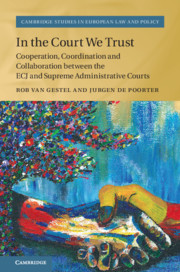 In the Court We Trust
In the Court We Trust Book contents
- In the Court We Trust
- Cambridge Studies in European Law and Policy
- In the Court We Trust
- Copyright page
- Dedication
- Contents
- Figures
- Series Editors’ Preface
- Preface
- 1 Why Don’t We Talk?
- 2 Dialogue as a Concept
- 3 Case Law Analysis
- 4 Results from the Interviews
- 5 Trust and Dialogue
- 6 Conclusion and Future Scenarios
- Index
1 - Why Don’t We Talk?
Published online by Cambridge University Press: 28 November 2019
- In the Court We Trust
- Cambridge Studies in European Law and Policy
- In the Court We Trust
- Copyright page
- Dedication
- Contents
- Figures
- Series Editors’ Preface
- Preface
- 1 Why Don’t We Talk?
- 2 Dialogue as a Concept
- 3 Case Law Analysis
- 4 Results from the Interviews
- 5 Trust and Dialogue
- 6 Conclusion and Future Scenarios
- Index
Summary
This chapter is setting the scene for the research. It starts from the astonishment that on the one hand the CJEU time and again underlines the dialogical nature of the preliminary reference procedure, while there are very view visible signs of an actual exchange of views and preparedness to share responsibility. What does this mean? Is there actually a judicial dialogue between the CJEU and highest administrative and, if not, why would the latter accept that their relationship is presented in terms of a shared responsibility and mutual cooperation? Answers to these questions are sought through a study of the literature on judicial law making, a case law analysis and interviews with judges. To this end we analytically split the research up in three phases: interaction before a preliminary question is submitted, during the procedure in Luxembourg and after the CJEU has ruled. Moreover, we explain why the focus lies on “regular” Supreme (Administrative) Courts instead of constitutional courts, which have dominated the debate on judicial dialogues so far.
- Type
- Chapter
- Information
- In the Court We TrustCooperation, Coordination and Collaboration between the ECJ and Supreme Administrative Courts, pp. 1 - 21Publisher: Cambridge University PressPrint publication year: 2019
